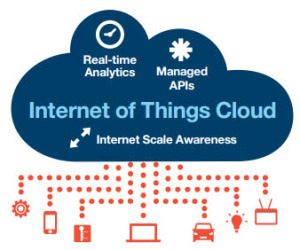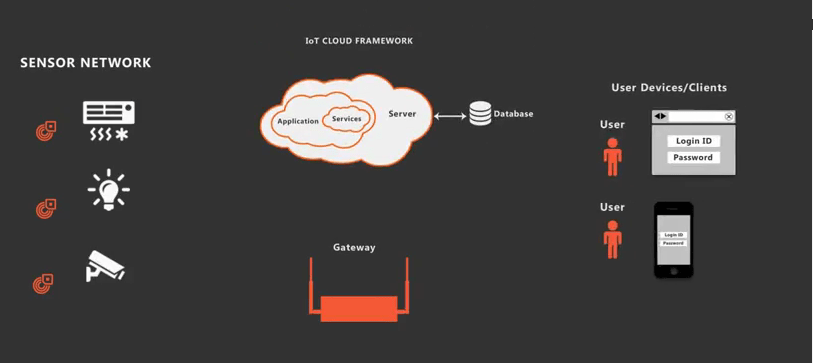While trying to understand an IoT solution, it is important to take note of one of its major components – Cloud Backend.
It has the responsibility of accepting tons of information from the IoT gateway, storing and processing it into actionable resources and sending them to the user interface (web app/mobile app/dashboard).
In some advanced IoT solutions, IoT cloud applications also support capabilities such as machine learning and artificial intelligence.
Such innovations in IoT cloud application development ensure that IoT solutions are able to solve complex business problems in areas of industrial automation, connected car, connected healthcare and more.
Role of IoT Cloud Platforms
There is an inextricable link between IoT and Cloud. The data collected by the sensors is quite huge in the case of an industrial application of IoT and a gateway is not capable of processing and storing it. This data needs to be stored in a secure database and processed in an affordable and scalable way. This is where IoT cloud computing comes into the picture.
The cloud is connected to the IoT gateway through the internet and receives all the data fed to the gateway by the sensors. There are a few protocols that connect gateways to the IoT cloud applications and the most common among them is MQTT.
Sensors collect and feed data at all times, and this huge chunk of data after the aggregation and some pre-processing is transferred to the cloud for storage and processing.

Source: IBM Center for Applied Insights
Depending on the nature of the IoT implementation the cloud may have varying degrees of complexity. In simple applications, the cloud may consist of a database that stores the data collected by the sensors, as well as the information of the users who possess the right to access/modify the data.In bigger and more complex implementations, the IoT cloud applications may also have the capability of machine learning, performing analytics, generating reports and more.
IoT Cloud Platforms – A Closer Look
Cloud is where the real action takes place. IoT cloud application along with the APIs and other interfaces manage the data and commands to and from the sensors or the gateways. Different APIs need to be integrated so that the data is read and stored accurately.
Some of the protocols such as MQTT, Websocket, CoAP, and AMQP are used to develop a powerful and secure interface that facilitates seamless communication between the sensors and the cloud. In order to ensure that there is no data loss during heavy inflow of data, a robust database is designed as well.

Best Practices for IoT Cloud Application Development
- Database DesignIoT entails a lot of data that need to be stored; hence a database is very critical to any IoT implementation. The best practices include analysing the number of sensor nodes and designing the database accordingly. Data management also needs to be optimized.
- Scalability of the ServerDepending on the current and projected number of end users of the IoT application, the cloud server must have the provision for auto-scaling. Services like AWS-EC2 enable this feature.
- Application CloningApplication cloning is a feature that helps avoid system overload in case of increased traffic. This is an effective way of handling heavy traffic and must be enabled on the IoT cloud application.
- Application SecurityHackers are always on the prowl and hence, IoT security is a major concern.
- The data packets sent across the network need to be encrypted
- TLS/SSL certificate should also be enabled so that remote access of IoT sensors and devices can be averted
How Cloud Complements IoT
The end users of the IoT infrastructure can be anywhere in the world and they need to be served round the clock, irrespective of their geographical locations and time zones. The IoT cloud architecture needs to be optimised so that this can be achieved.
IoT and cloud complement each other perfectly. While the former collects data and serves as a source of data, the latter acts as the destination as well as the distributor.
Benefits of Cloud in an IoT Ecosystem
- Caters to data storage and processing demands of IoTIoT has huge potential and in the near future, we could see all kinds of physical entities connected to each other. This would require raw computing power and only cloud can provide that.
- Advanced analytics and monitoringWith a plethora of ‘things’ now being connected, there would be a need for constant analysis and monitoring in order to ensure seamless IoT experience to the users. An advanced cloud architecture will ensure that the IoT ecosystem is equipped with such capabilities.
- Smoother inter-device connectivityIn an IoT solution, the sensors not only talk to the users, they also interact with each other. IoT cloud applications, along with the IoT gateway, ensure that different sensors and actuators are able to talk to each other without any incompatibility.
IoT cloud application development is backed by some really advanced and proven technologies like Amazon EC2 in combination with EBS (Elastic Block Store). A few others are G Suite from Google, and Microsoft Azure.
With many IoT cloud application development companies joining the revolution, we can expect a lot of interesting IoT innovations over the next few years with cloud at their core.

